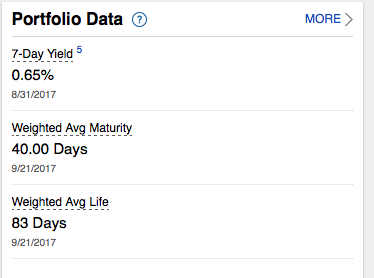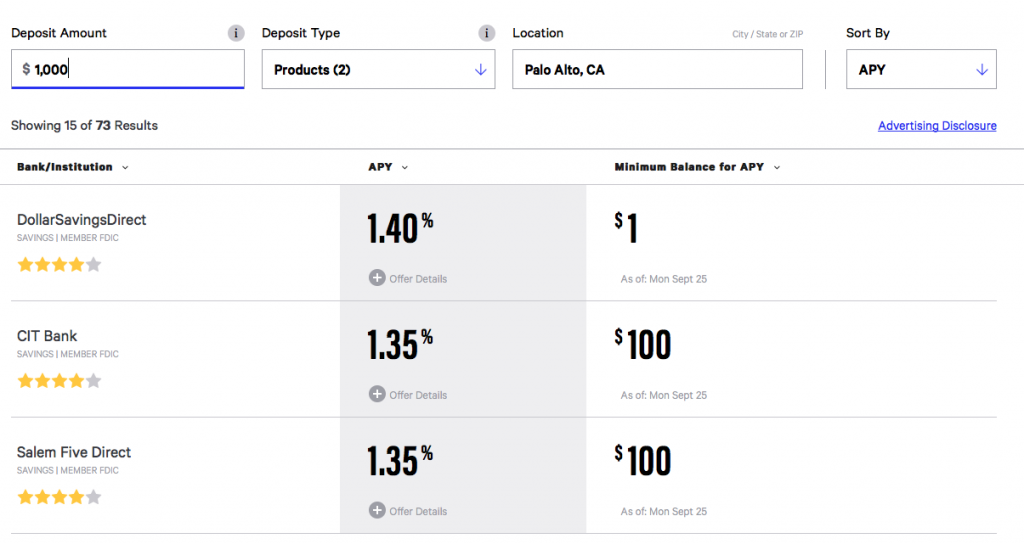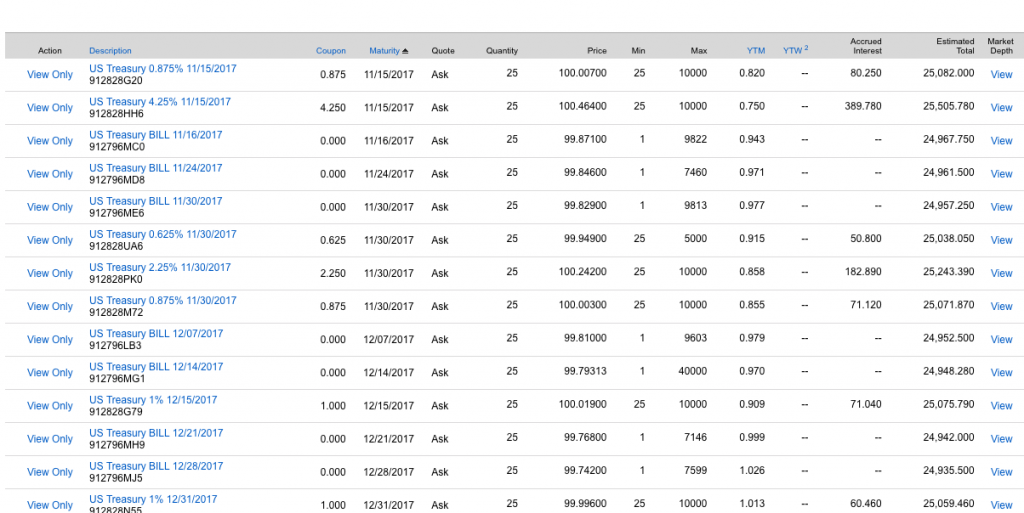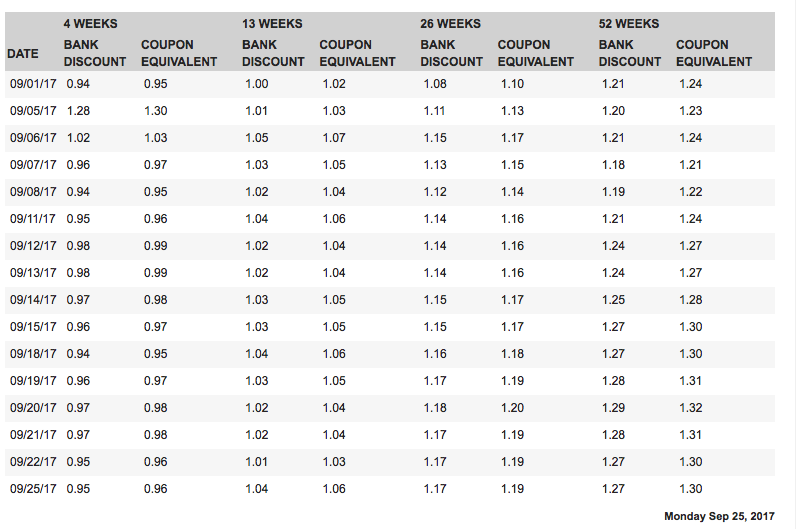Re-balance Cycle Reminder All MyPlanIQ’s newsletters are archived here.
For regular SAA and TAA portfolios, the next re-balance will be on Monday, October 9, 2017. You can also find the re-balance calendar for 2017 on ‘Dashboard‘ page once you log in.
As a reminder to expert users: advanced portfolios are still re-balanced based on their original re-balance schedules and they are not the same as those used in Strategic and Tactical Asset Allocation (SAA and TAA) portfolios of a plan.
Please note that we now list the next re-balance date on every portfolio page.
Fees In Cash Investments
Expenses/fees in mutual funds have come down a lot since John Bogle, the founder of Vanguard Company, first introduced index funds and started the low cost investment crusade in 1970s. The 0.03% expense recently instigated in Schwab S&P 500 index fund (SWPPX) signifies how much fees in mutual funds have come down. Marketing plots or not, investors now can expect to spend 0.1% or so in many stock and bond index funds.
However, fees in cash investments or ultra short term cash like investments or savings are still extremely high. They often go unnoticed. To illustrate:
| Funds | Annual Expense | Minimum | 7-Day Yield |
|---|---|---|---|
| SWPPX (Schwab S&P 500 Index) | 0.03% | ||
| VFINX (Vanguard 500 Index Investor) | 0.14% | ||
| Vanguard total bond market index fund (VBMFX) | 0.15% | ||
| Schwab Treasury Money Market Fund | 0.65%/0.77%* | $25,000 | 0.7% |
| Schwab Value Advantage Money Market Fund | 0.45%/0.58% | $25,000 | 0.9% |
| Fidelity Treasury Money Market Fund | 0.42% | 0 | 0.65% |
| Vanguard Treasury Money Market Fund (VMFXX) | 0.11% | $3,000 | 0.98% |
*: net expense ratio/gross expense ratio (net expense ratio represents fund management’s voluntary fee waiver that might go away anytime)
You would think for safest (and thus dullest?) money market funds, their expense ratios should be lower than trickier/riskier stock or bond funds. How complicated can it be to invest in some of the safest short term debts such as Treasury bills. You would be wrong, in fact, wrong by a big margin!
Notice a Treasury money market fund merely purchase US Treasury bills that are mature in short amount of time, as short as one month. As usual, you can only purchase these funds in their brokerages respectively.
Based on Fidelity, the Fidelity Treasury money market fund’s average maturity is 40 days:
So this money market fund’s investor is paying 0.42% annually to just get invested in US Treasury bills (mature in one year or less is called Bills).
Similarly, Vanguard money market fund has a average 58 days maturity. Though its expense is much lower (0.11%), it’s about the same as its stock index funds or bond fund (VBMFX).
Investors are also paying similar (or slightly higher) fees to invest in a prime money market fund that can invest in other government debts and high quality corporate bank loans in addition to Treasury bills.
Banking
Banks also offer high yield savings or money market accounts. One can find some high yield savings or money market accounts through a website like bankrate.com. For example, here are some of the best rates offered nationwide:
Unfortunately, these credit unions/banks do not always offer the best rates. Many of them just offer some promotion high yielding rates to attract new customers. To get such a good rate, one has to open a new account in a bank and then transfer money from/back to his/her primary bank account. This is too much hassle.
On the other hand, the rates of money market accounts and savings accounts in big banks are almost zero in today’s low rate environment. For example, our last check with Bank of America indicates it offers 0.03% to 0.06% interest rates!
Do it yourself, Treasury bills
It turns out that you can do better, much better when it comes to invest in Treasury bills. There are two ways for one to purchase Treasury bills.
The first way is to purchase Treasury bills from your brokerage account. For example, from a Schwab brokerage account, one can purchase Treasury bills for free:
At the moment, you can get a T-Bill that matures in 50 days to yield 0.85%-0.9%. For a 3 month T-Bill, you can get about 1% yield. You can find this from the YTM (Yield To Maturity) column.
A broker charges some nominal fee when you purchase Treasuries through them.
The other way is to purchase newly issues T-Bills through public auction from TreasuryDirect.com. You can open an account online on the website and then link with your bank account. You can then simply buy one of the safest and most liquid short term cash equivalent T-bill without paying any commission and fee. At the moment, here are the rates:
So, one can get an interest rate 0.95% one month T-bill, or 1.04% 3 month T-bill or 1.27% one year T-bill from this website. All you need to do is to login to your account and issue purchase orders. The minimum amount is $100 and it increments with $100 too. When a bill matures, you can re-invest or just move the money back to your bank account. Thus, this is actually very flexible for even small accounts. The one month maturity bills are also liquid and flexible enough for most spending.
Summary
Cash investments are the final frontier in low cost investing. Banks and/or brokerages, acting as middlemen, have charged extremely high fees traditionally. Roughly speaking,their fees can be from 1% to 3%. This has not come under much public scrutiny. However, with some effort, investors can completely eliminate fees by going directly to TreasuryDirect.com to purchase the safest debts.
To get even better yields, investors can also purchase brokered Certificate of Deposits (CDs) that have various maturities (such as 3, 6, 9, 12 and 24 months). Banks make CDs by pulling a basket of bank loans (to high quality companies) and government debts (such as Treasury bills). CDs are insured by FDIC up to $250,000. At the moment, for example, one can purchase a 3 month CD from Schwab that yields 1.25%.
In a word, if you put some effort (maybe 10-20 minutes monthly?), you can save yourself hundreds to thousands of dollars.
Market Overview
Investors seem to start to find out it’s too expensive for growth stocks and now they started to rotate to value stocks. This resulted in some loss in high growth stocks. However, small cap stocks, high yield bonds and foreign bonds are all still exhibiting strength. Again, we are not seeing considerable waning of investors’ risk appetite. But we need to be reminded that the sentiment can change quickly, especially in an elevated market. So stay the course and manage risk accordingly.
For more detailed asset trend scores, please refer to 360° Market Overview.
Now that the Trump administration has been in the office for more than half a year, it has stumbled and encountered many difficulties to implement its promised changes in terms of tax cuts, job stimulation and infrastructure spending. On the other hand, stocks continued to ascend, regardless of the progress. Looking ahead, however, we remain convinced that markets will experience more volatilities at some point when reality finally sets in.
In terms of investments, U.S. stock valuation is at a historically high level. It is thus not a good time to take excessive risk. However, we remain optimistic on U.S. economy in the long term and believe much better investment opportunities will arise in the future.
We again would like to stress for any new investor and new money, the best way to step into this kind of markets is through dollar cost average (DCA), i.e. invest and/or follow a model portfolio in several phases (such as 2 or 3 months) instead of the whole sum at one shot.
Latest Articles
- September 18, 2017: Conservative Portfolios Review
- September 11, 2017: International Diversification Effect
- September 4, 2017: Invest And Speculate Revisited
- August 28, 2017: Total Return Bond Fund Portfolios: Where Do They Fit?
- August 21, 2017: Portfolio Performance: A Walk In The Past
- August 14, 2017: Fidelity Commission Free ETFs Update
- August 7, 2017: I Didn’t Learn Anything — Mistake vs. Temporary Underperformance
- July 31, 2017: Asset Classes And Fund Choices: A Primer
- July 24, 2017: Total Return Bond Fund Portfolios And Cash
- July 17, 2017: Long Term Stock Holding Periods For Retirement
- July 10, 2017: Half Year Asset Trend Review
- June 26, 2017: How To Beat The Best Balanced Allocation Fund
- June 19, 2017: Newsletter Collection Update
- June 12, 2017: A Mixed Bag Performance of Momentum Investing
- June 5, 2017: How To Start A New Portfolio
- May 29, 2017: Alternative Assets And Their Role In Portfolios
- May 22, 2017: Summer Seasonality And Portfolio Management
- May 15, 2017: Cash: Banking Or Investing?
- May 8, 2017: Holding Period of Long Term Timing Portfolios
- May 1, 2017: Debate on Risk vs. Volatility
- April 24, 2017: The Long Term Stock Market Timing Return Since 1871
- April 17, 2017: Risk vs. Volatility: Long Term Stock Market Returns
- April 10, 2017: Total Return Bond ETFs And Portfolios
- April 3, 2017: Quarter End Asset Trend Review
- March 27, 2017: Practical Consideration For IRAs And 401k Accounts
- March 20, 2017: Fund Fees: That’s (Still) Outrageous
- March 13, 2017: Long Term Stock Valuation Review
- March 6, 2017: Asset Classes for Retirement Investments
- February 27, 2017: Fidelity Total Bond Fund Review
- February 20, 2017: Long Term Stock Timing Based Portfolios And Their Roles
- February 13, 2017: Alternative Investment Portfolios Review
- February 6, 2017: Tax Free Municipal Bond Investments Review
- January 30, 2017: Brokerage Specific Conservative Portfolios
- January 23, 2017: Fixed Income Portfolio Review
- January 16, 2017: Long Term Trend Following Portfolio Review
- January 9, 2017: Tactical Asset Allocation Review
- January 3, 2017: Strategic Asset Allocation Review
- December 12, 2016: Enhanced Index Funds
- December 5, 2016: Review Of Broad Base Core Mutual Funds For Brokerages
- November 28, 2016: Core Index ETFs Review
- November 21, 2016: International Exposure Of U.S. Large Companies
- November 14, 2016: Asset Trends After The Election
- November 7, 2016: Rising Rate And Current Bond Trend
- October 31, 2016: Economy Power And Long Term Stock Returns
- October 24, 2016: Current Commodity Trend And Managed Futures
- October 17, 2016: Investment Mistakes And Good Or Bad Investment Strategies
- October 10, 2016: Momentum Investing Review
- October 3, 2016: Survey & Feedback
- September 26, 2016: Fixed Income Investing: Actively Managed Funds vs. Index Funds
- September 19, 2016: Stock Investing: Actively Managed Funds vs. Index Funds
- September 12, 2016: Newsletter Update
- September 5, 2016: Overvalued Markets And Long Term Timing Strategies
- August 29, 2016: Your 401K Finally Draws Attention
- August 22, 2016: Inflation Protected Securities TIPS For Current Overvalued Markets
- August 15, 2016: Risk On: Emerging Market Stocks And Small Cap Stocks
- August 8, 2016: Portfolio Construction Using Stock ETFs And Bond Mutual Funds
- August 1, 2016: Adding Value To Your Own Investments
- July 25, 2016: Tactical Asset Allocation Funds Review
- July 18, 2016: Strategic Asset Allocation & Lazy Portfolio Review
- July 11, 2016: Asset Trend Review
- June 27, 2016: Secular Cycles For Tactical And Strategic Investment Strategies
- June 20, 2016: A World of Debt
- June 13, 2016: Managed Futures For Portfolio Building
- June 6, 2016: Newsletter Summary
- May 30, 2016: Swensen Portfolio And Permanent Portfolios
- May 23, 2016: AAII Article And Some Web Changes
- May 16, 2016: The PIMCO (Dis)Advantages
- May 9, 2016: Boost Your Dull Summer Investments
- May 2, 2016: Low Cost Index Fund Investing
- April 25, 2016: Tax Free Municipal Bond Funds & Portfolios
- April 18, 2016: Asset Class Trend Review
- April 11, 2016: Construction of Sound And Conservative Portfolios
- March 28, 2016: Total Return Bond ETFs Review
- March 21, 2016: Small And Large Company Stock Performance In Different Economic Expansion Cycles
- March 14, 2016: Are Tactical And Timing Strategies Losing Steam?
- March 7, 2016: Defined Maturity Bond Fund Analysis
- February 29, 2016: Smart Strategic Asset Allocation Rebalance When Market Trend Changes
- February 22, 2016: Be Cash Smart
- February 15, 2016: Bond ETF Portfolios
- February 8, 2016: Newsletter Collection Update
- February 1, 2016: Total Return Bond Fund Portfolios In A Volatile Period
- January 25, 2016: Alternative Portfolios Review
- January 18, 2016: Strategic Asset Allocation: A Cautious Outlook
- January 11, 2016: Review Of Trend Following Tactical Asset Allocation
- January 4, 2016: What Worked And Didn’t In 2015
- December 21, 2015: Distressed Assets
- December 14, 2015: High Yield Bonds And Their Correlation With Stocks
- December 7, 2015: Diversification And Global Allocation
- November 30, 2015: Investors and Speculators Combined
- November 23, 2015: Active Stock Fund Performance Consistency
- November 16, 2015: Permanent, Risk Parity And Alternative Portfolios Review
- November 9, 2015: Broad Base Core Mutual Fund Review
- November 2, 2015: Broad Base Index Core ETFs Review
- October 26, 2015: Total Return Bond Fund Review
- October 19, 2015: Advanced Portfolio Review
- October 12, 2015: What About Commodities?
- October 5, 2015: Core Satellite Portfolios In A 401k Account
- September 28, 2015: Risk Managed Strategic Asset Allocation Portfolios Revisited
- September 21, 2015: Quest For The Best Investment Strategy
- September 14, 2015: Core Satellite Portfolios In Market Turmoil
- September 7, 2015: Market Rout Creates An Opportunity to Reposition Your Portfolios
- August 31, 2015: Review of Asset Allocation Funds and Portfolios
- August 24, 2015: Market Rout And Your Portfolios
- August 17, 2015: ETF or Mutual Fund Based Portfolios
- August 10, 2015: Updated Newsletter Collection
- August 3, 2015: Slippery Asset Trends
- July 27, 2015: Performance Dispersion Among Momentum Based Portfolios
- July 20, 2015: Global Balanced Portfolio Benchmarks
- July 13, 2015: Pain in Tactical Portfolios
- July 6, 2015: Fixed Income Total Return Bond Funds In Strategic Asset Allocation Portfolios
- June 29, 2015: Core ETF Commission Free Portfolios
- June 22, 2015: Secular Asset Trends
- June 15, 2015: Giving Up Bonds?
- June 1, 2015: Summer Blues?
- May 26, 2015: Cash, Bonds and Stocks In A Rising Rate Environment
- May 18, 2015: Portfolio Update
- May 11, 2015: Pain in Fixed Income?
- May 4, 2015: The Balanced Stock and Long Term Treasury Bond Portfolios
- April 27, 2015: Long Term Treasury Bond Behavior
- April 20, 2015: 529 College Savings Plan Rebalance Policy Change
- April 13, 2015: Total Return Bond Funds As Smart Cash
- April 6, 2015: The Low Return Environment
- March 30, 2015: Brokerage Specific Core Mutual Fund Portfolios 2
- March 23, 2015: Investment Arithmetic for Long Term Investments
- March 16, 2015: Brokerage Specific Core Mutual Fund Portfolios
- March 9, 2015: Newsletter Collection Update
- March 2, 2015: Total Return Bond ETFs
- February 23, 2015: Why Is Global Tactical Asset Allocation Not Popular?
- February 16, 2015: Where Are Permanent Portfolios Going?
- February 9, 2015: How Have Asset Allocation Funds Done?
- February 2, 2015: Risk Management Everywhere
- January 26, 2015: Composite Portfolios Review
- January 19, 2015: Fixed Income Investing Review
- January 12, 2015: How Does Trend Following Tactical Asset Allocation Strategy Deliver Returns
- January 5, 2015: When Forecast Fails
- December 22, 2014: Long Term Asset Returns: How Long Is Long?
- December 15, 2014: Beaten Down Assets
- December 8, 2014: Implementing Core Asset Portfolios In a Brokerage
- December 1, 2014: Two Key Issues of Investment Strategies
- November 24, 2014: Holiday Readings
- November 17, 2014: Retirement Spending Portfolios Update
- November 10, 2014: Fixed Income Or Cash
- November 3, 2014: Asset Trend Review
- October 27, 2014: Investment Loss, Mistakes And Market Cycles
- October 20, 2014: Strategic Portfolios With Managed Volatility
- October 13, 2014: Embrace Volatility
- October 6, 2014: Tips For 401k Open Enrollment
- September 29, 2014: What Can We Learn From Bill Gross’ Departure From PIMCO?
- September 22, 2014: Why Total Return Bond Funds?
- September 15, 2014: Equity And Total Return Bond Fund Composite Portfolios
- September 8, 2014: Momentum Based Portfolios Review
- September 1, 2014: Risk & Diversification: Mint.com Interview
- August 25, 2014: Remember Risk
- August 18, 2014: Consistency, The Most Important Edge In Investing: Tactical Case
- August 11, 2014: What To Do In Overvalued Stock Markets
- August 4, 2014: Is This The Peak Or Correction?
- July 28, 2014: Stock Musings
- July 21, 2014: Permanent Portfolios & Four Pillar Foundation Based Framework
- July 14, 2014: Composite Portfolios Review
- July 7, 2014: Portfolio Behavior During Market Corrections
- June 30, 2014: Half Year Brokerage ETF and Mutual Fund Portfolios Review
- June 23, 2014: Newsletter Collection Update
- June 16, 2014: There Are Always Lottery Winners
- June 9, 2014: The Arithmetic of Investment Mistakes
- June 2, 2014: Tips On Portfolio Rebalance
- May 26, 2014: In Praise Of Low Cost Core Asset Class Based Portfolios
- May 19, 2014: Consistency, The Most Important Edge In Investing: Strategic Case
- May 12, 2014: How To Handle An Elevated Overvalued Market
- May 5, 2014: Asset Allocation Funds Review
- April 28, 2014: Now The Economy Backs To The ‘Old Normal’, Should Our Investments Too?
- April 21, 2014: Total Return Bond Investing In The Current Market Environment
Enjoy Newsletter
How can we improve this newsletter? Please take our survey
–Thanks to those who have already contributed — we appreciate it.






 Diversified Asset Allocation Portfolios For Your Plans
Diversified Asset Allocation Portfolios For Your Plans
